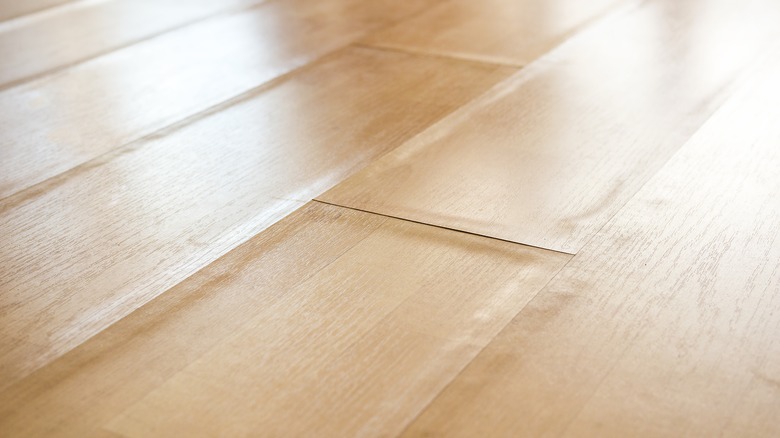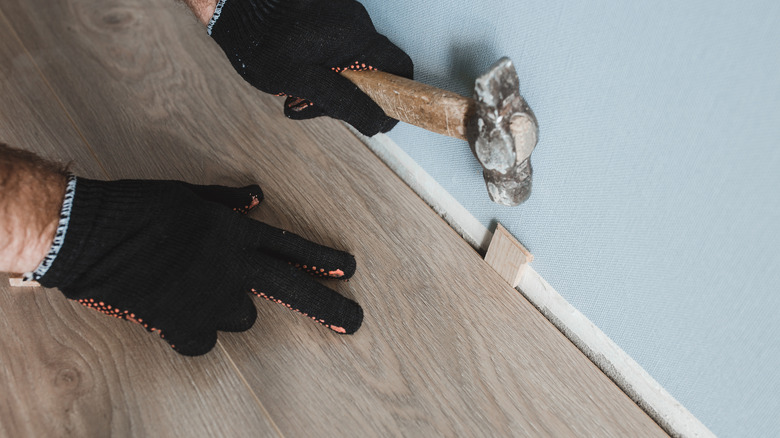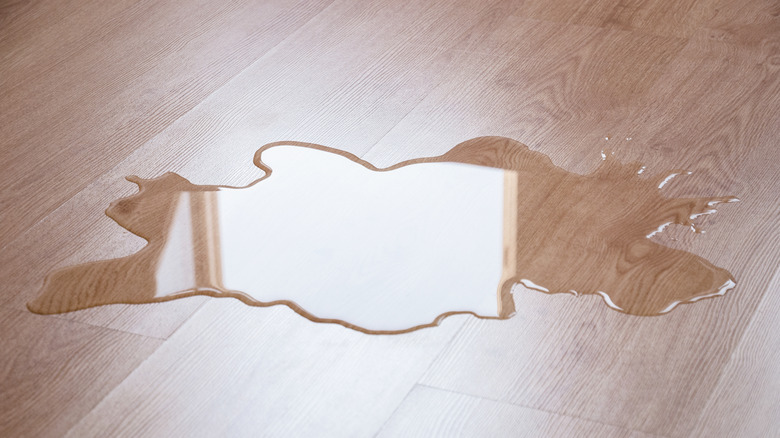Tips To Prevent Your Laminate Flooring From Lifting
Laminate floors have given hardwood a run for its money over the last decade. Sales have been steadily climbing each year as more and more homeowners embrace its budget-friendly price point, durability, and ease of DIY. Plus, the flooring now closely mimics real hardwood, making it a no-brainer of a purchase. Randy McKellar, marketing manager of Lions Floor, told Floor Covering News, "Modern manufacturing techniques have greatly improved the aesthetics of laminate flooring, allowing it to closely mimic the appearance of natural materials like hardwood, stone or tile." While it might have benefits over hardwood — like being more water- and scratch-resistant — it does have one downside: It can lift. But luckily, there are easy precautions you can take to prevent this from happening.
There are usually two main reasons why laminate floorboards lift: either shoddy installation or moisture. If the issue is poor installation, then your laminate flooring was probably installed all the way to the wall, lacking an expansion gap. Floorboards constrict and expand as the temperature rises and falls over the seasons, and the expansion gap accommodates these fluctuations. If it was installed without one, you will eventually get buckling near the walls. The second issue could be having too much moisture, whether because of standing water on the boards or humidity in the room. Here is a closer look into how to prevent your flooring from lifting by avoiding these issues.
Prevent your flooring from lifting by installing an expansion gap
Just like hardwood, laminate floors expand and contract depending on the room's temperature. This is unavoidable, so to prevent the boards from expanding into each other and lifting, contractors leave something called an "expansion gap" near the walls. For laminate floors, that gap is usually 1/4 inch from the wall. It can be created by leaving spacers between the wall and flooring to create a consistent line around the room's perimeter. Baseboards then cover it, so the opening isn't noticeable.
Make sure you also leave an expansion gap around other elements in the room, like a fireplace, built-in cabinets, or radiators. You also need a gap where two different floorings meet, like the floors below a doorway. A transition strip can then cover it. You also don't want to go the other way and create too large of a gap. This can lead to dirt and debris falling into it, making a mess over the years.
Stop your floors from lifting by avoiding humidity and moisture
While laminate flooring is water-resistant, it isn't waterproof. When looking at the dos and don'ts for cleaning your laminate floors, experts warn against drenching the area with mop water or leaving standing water on the boards. Doing so can cause the floors to buckle and warp, leading to lifting. To avoid this, choose your cleaning supplies wisely. Marla Mock, president of Molly Maid, told Martha Stewart, "If you have a lot of laminate flooring make sure you get a mop for laminate that won't hold too much water." You can also use a spin mop, which lets you wring most of the water from the head, leaving it only slightly damp.
You also want to avoid humidity in the house. If the humidity levels creep over 60%, the floorboards can become saturated in moisture, causing them to expand. If that happens, certain sections can inevitably lift. This might not be a danger for regions that experience the odd humid day, but if you consistently get muggy weather, it would be wise to invest in a dehumidifier. You want the levels to hover between 35% and 55%, and the gadget can help whisk some of the moisture from the air.



